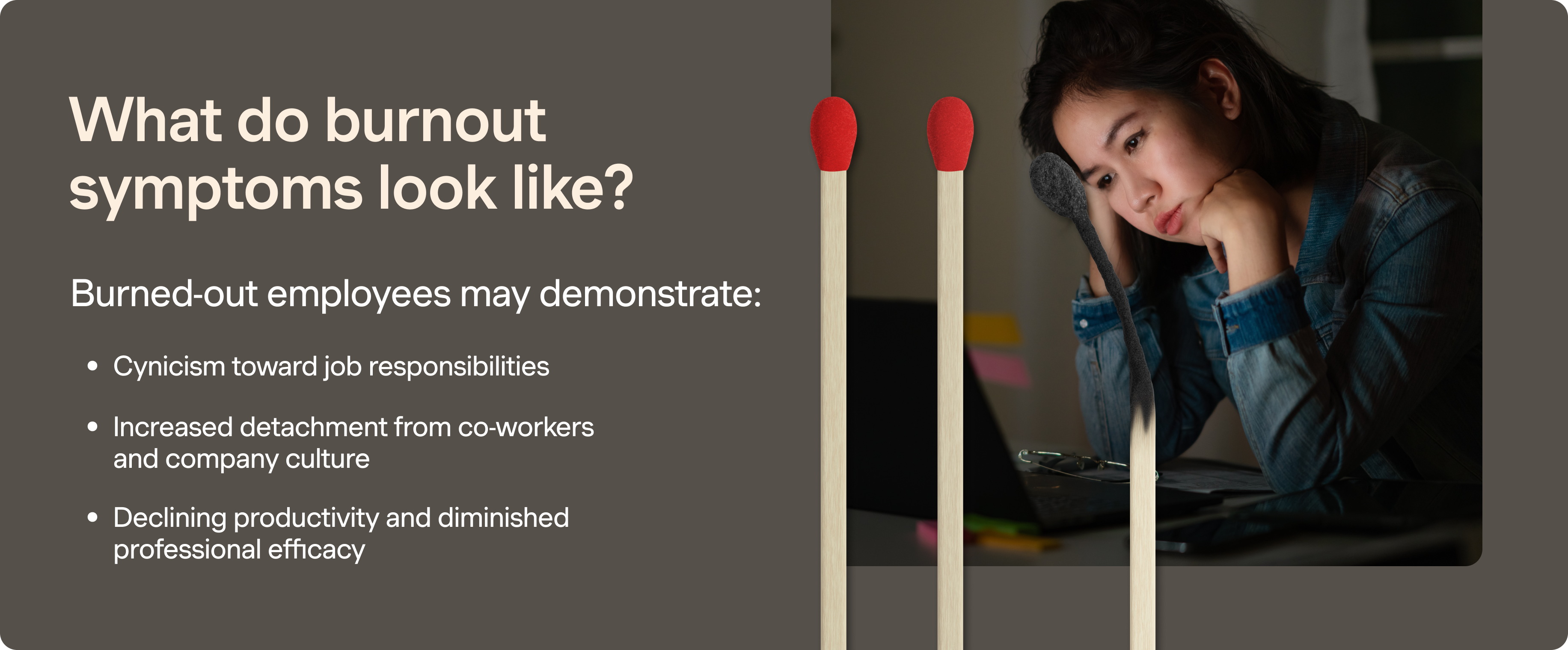Burnout is no longer just a personal struggle—it’s a company-wide issue with serious consequences for performance, culture, and the bottom line.
Across industries, employees are emotionally drained, managers are stretched to their limits, and HR teams are overwhelmed by the growing volume of mental health concerns. The old ways of addressing burnout—offering a wellness stipend, a few mental health days, or a traditional EAP aren’t cutting it anymore.
Workplace burnout is now a business risk. It contributes to absenteeism, lost productivity, increased healthcare costs, and high turnover. And for organizations that aren’t paying attention, it could quietly drive major disruptions.
But burnout is also preventable if you know what to look for and are willing to treat it as the systemic issue it truly is.
Burnout isn’t new, but the way we solve it needs to be. Get the guide that’s challenging outdated playbooks and delivering results.

What is employee burnout?
Employee burnout is a state of chronic stress that results in emotional exhaustion, detachment from work, and reduced performance. It often builds over time—making it difficult to identify early—and can show up in ways that look like disengagement or low motivation.
You may notice employees becoming unusually irritable or withdrawn. They might seem less confident in their work, struggle to concentrate, or begin questioning the value of their role. Some may stop speaking up in meetings, miss deadlines, or start calling in sick more often.
And burnout isn’t just a concern for high-pressure industries. A recent national survey found that 40% of U.S. workers experience burnout, with the highest rates among project managers, healthcare workers, community service professionals, and educators. Meanwhile, 54% of mid-level employees reported feeling burned out in the past year—compared to 40% of entry-level employees.
Burnout doesn't discriminate, but it often hits the most committed and hardest-working employees first.
The high cost of employee burnout
When burnout goes unaddressed, it doesn’t just affect morale—it directly impacts organizational performance and costs. According to Gallup, 76% of employees say they’ve experienced burnout at some point, and 28% feel burned out “very often” or “always.” That kind of chronic exhaustion doesn’t stay contained.
In a separate Gallup study, burned-out employees are:
- 63% more likely to take a sick day
- 2.6 times more likely to be looking for another job
- Less confident, less engaged, and less productive overall
Harvard Business Review estimates the annual cost of burnout-related healthcare spending is between $125 and $190 billion. Add in the costs of turnover—roughly $15,000 per lost employee—and it’s clear that burnout is more than just a wellbeing issue. It’s a business threat.
HR professionals are feeling the effects too. In one SHRM report, over 50% of HR teams reported working beyond their capacity, with many citing understaffing as a major factor contributing to their own burnout.

How to prevent and address employee burnout
Burnout isn’t just an individual problem—it’s a reflection of organizational systems. Preventing it requires thoughtful, proactive strategies that go beyond perks and check-the-box programs. Here’s what that looks like in practice.
Prioritize manager support and training
Managers are your first line of defense against burnout, but they’re also some of the most impacted. They're balancing their own workloads while trying to support employees, navigate change, and maintain team morale.
Equipping managers with the right tools and training to recognize burnout signs, create safe team dynamics, and have supportive mental health conversations can make a huge difference. When managers feel supported themselves, they’re far better positioned to support others.
Reassess workloads and expectations
In many organizations, high performers are rewarded with more responsibilities, but not necessarily more time or resources. This imbalance risks burning out your best people and reinforces a culture where overwork is normalized.
Instead, take time to evaluate role expectations, adjust workloads, and ensure priorities are realistic. Encourage teams to focus on outcomes, not just output. And make sure high performers aren’t silently paying the price for their success.
Go beyond surface-level mental health support
Traditional EAPs often involve long wait times, confusing access processes, and limited session availability. For someone already burned out, these barriers can feel insurmountable.
A more effective approach includes fast access to high-quality care, personalized support plans, and seamless coordination between HR, managers, and providers. Employees shouldn’t have to work harder just to feel better.
Create space to rest and recharge
Preventing burnout isn’t just about offering PTO—it’s about creating a culture where people actually feel safe taking it.
This might mean modeling time off at the leadership level, encouraging boundaries between work and personal life, and giving people the flexibility to manage their energy in ways that work for them. For some, that might be a mental health day. For others, it might be shifting hours or working from home when needed.
The point is that time to rest shouldn’t feel like an exception. It should feel like part of how work gets done.
Build a culture of fairness and connection
Burnout often stems from feeling undervalued, invisible, or stuck. It’s intensified by favoritism, lack of transparency, or inequities in pay and promotion.
Creating a culture that actively supports fairness, inclusion, and real human connection is essential. This means listening to employee feedback, addressing systemic gaps, and giving people meaningful ways to grow—not just more work to do.
Provide mental health support that meets the moment
Preventing burnout starts with giving employees access to effective, easy-to-use mental health care. Traditional EAPs often fall short, with limited provider networks, long wait times, and confusing processes that discourage use—especially when someone is already overwhelmed.
Modern solutions like Spring Health offer faster access to personalized care, including therapy, coaching, and digital tools. Employees are matched with support through a short, clinically-validated assessment and can typically book their first session in less than two days.
When care is easy to access and tailored to each person, employees are more likely to engage early—before burnout becomes a crisis.
Burnout prevention is a business strategy
Organizations that invest in preventing employee burnout aren’t just doing the right thing for their people—they’re making a smart business decision.
Burnout directly impacts your most critical metrics: retention, productivity, engagement, and healthcare costs. When employees are mentally depleted, they’re not just struggling to meet expectations—they’re more likely to miss work, disengage, or leave altogether. Replacing them isn’t just disruptive—it’s expensive.
That’s why forward-thinking companies are treating mental health not as a perk, but as a pillar of operational success. They’re embedding it into their leadership practices, workflows, and culture because they know that preventing burnout strengthens every part of the business.
When employees feel supported, they show up with more energy, focus, and creativity. Teams communicate better, turnover slows, and leaders can focus on growth instead of damage control.
Burnout prevention isn’t just a people strategy—it’s a performance strategy. And in today’s climate, it may be the most important investment your organization can make.
Burnout is breaking your workforce and the old solutions aren’t working. Get the guide that helps you tackle it at the root.

Spring Health is a comprehensive mental health solution for employers and health plans. Unlike any other solution, we use clinically validated technology called Precision Mental Healthcare to pinpoint and deliver exactly what will work for each person—whether that’s meditation, coaching, therapy, medication, and beyond. Today, Spring Health supports over 4,500 organizations, from startups to multinational Fortune 500 corporations, and is a preferred mental health provider to companies like General Mills, Bain, and DocuSign.


.png)
.png)
.png)




.png)




.png)


.png)



